Body Movements
The changing position of the body or any body part is called movement. It can involve the movement of a single body part (movement of the hand while writing), different parts of the body (during a workout), or the whole body (while walking).
Even when we are sitting still, many movements like blinking of eyes, beating of heart, etc. occur in our body, The Movement of animals from one place to another is known as locomotion.
There are different ways in which animals show locomotory movements like cows walking, snakes slithering, insects crawling, birds flying, fish swimming, etc. In this chapter, we will study the different movements that occur In different living organisms.

Human Body And Its Movements
Movement in human beings takes place with the help of the skeletal system (consisting of bones and cartilage) and muscular system (having muscles). Bone is the hard structural tissue that gives shape to our body. Our body consists of many bones.
The bones cannot be bent. We can bend our body part only at those points (places) where two or more bones are joined together. Muscles are attached to the bones. The contraction and relaxation of muscles bring about movement in the human body.
Read and Learn More Class 6 Science Notes
Joints Of The Body
The places where two or more bones meet are called joints. They allow body movements like bending and rotation of limbs, bending of back, and sideways movement of the neck.
Types Of Joints
Different types of joints are present in the human body that help us to carry out different movements and activities.
1. Freely Movable Joints
The joints in which one bone moves freely on the other are called freely movable joints. Such joints are found in the shoulder, hip, knee, elbow, ankle, and wrist.
Freely movable joints are of the following types
Ball and Socket Joint
The joints in which the rounded, ball-like end of one bone fits into the hollow part (socket) of the other bone are called ball and socket joints. The bone with the ball-like head is freely movable in all directions.
For example, the shoulder joint between the shoulder bone and the head of the upper arm bone and the hip joint, between the hip bone and thigh bone.
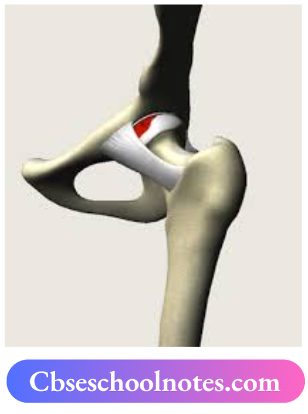
Pivotal Joint
The joint in which the rounded surface of one bone fits into a ring formed by the other one is called the pivotal joint, for example joint between the neck and head. It allows us to bend our head forward and backward and turn right or left. It allows rotational movements only. In a pivotal joint, a cylindrical bone rotates in a ring.

Hinge Joints
The joints that allow movement of bones in only one direction, i.e. either forward or backward are called hinge joints. These joints allow movements like a hinge to its door shows movements. These are present in the elbow, knee, finger joints, and jaw.
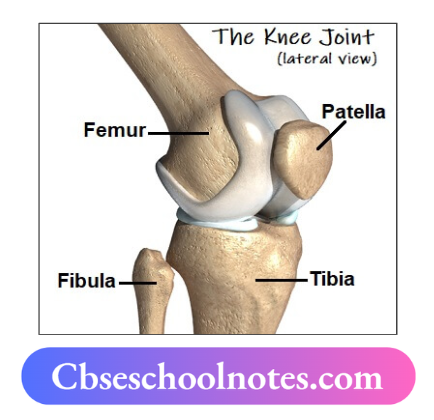
Fixed Joints
The joints in which the bones are fixed and held so tightly that they cannot move at all are called fixed joints. These joints are also called immovable joints. For example, the bones ofour skull are held together tightly with such joints. Our upper jaw is also fixed to skull bones with the help of fixed joints.
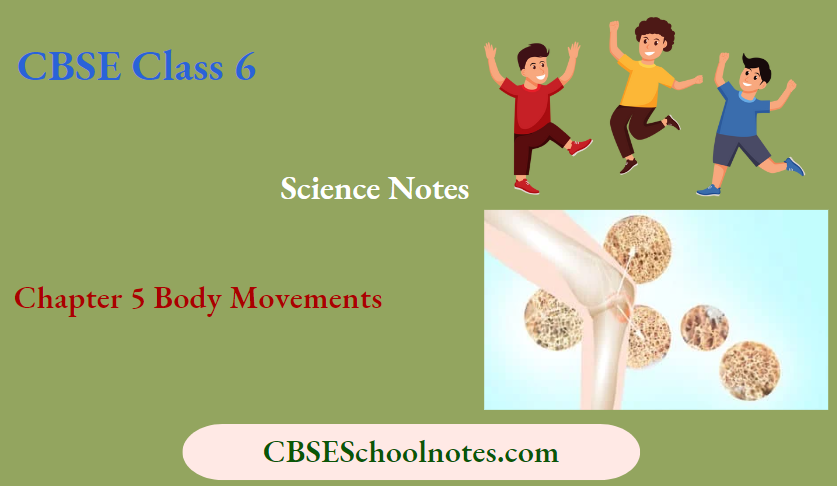
Human Skeletal System
The bones (hard tissues) and cartilage (soft tissues) in our body form a framework that supports the whole body and gives a shape to it.
This framework is called the skeleton. The human skeleton is composed of around 305 bones at birth. The number of bones in the skeleton changes with age. It decreases to 206 bones by adulthood after some bones have fused.
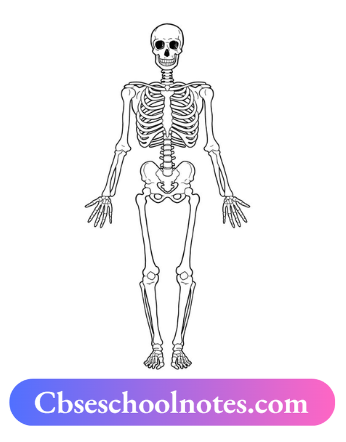
Parts of the Skeleton System
The skeleton system consists of various bones. Some important bones are as follows
1. Skull
It is the bony part ofour head, which is made up of 22 skull bones. These are among the hardest bones ofour body. All the bones of the skull except the lower jaw are fixed.
It performs the following functions
- The skull protects the brain.
- It gives shape to our face and head.
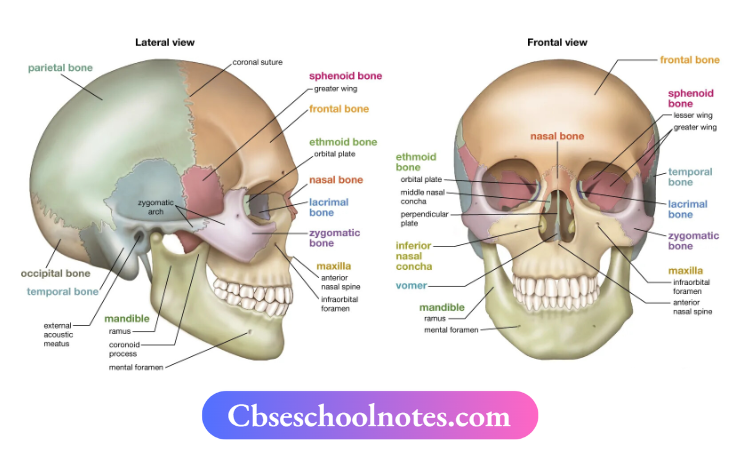
2. Ribcage
The ribs are the curved bones present in our chest region. Each rib is attached to the breast bone in front and the backbone at the back to form a box-like structure. This is called the ribcage. It is composed of12 pairs of ribs. All the ribs are joined to the backbone, but only a few ribs are attached to the chest or breast bone.
It performs the following functions
- The ribcage protects vital internal organs like the heart, lungs, and liver.
- It takes part in breathing movements along with the lungs.

3. Backbone
If we put a finger at the back of the neck and move it while pressing downwards, we can feel a long hard structure.
This is our backbone, which is a long, hollow, rod-like structure running from the neck to the hips. It is made up of 33 small bones that are placed over each other. Each small bone is called vertebrae.
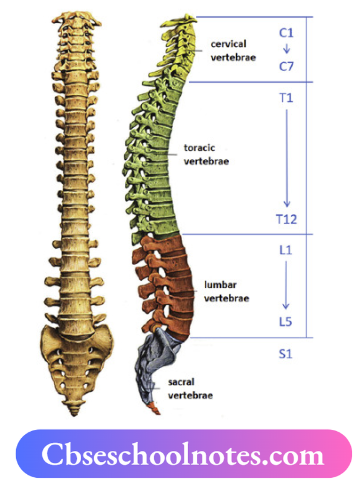
It performs the following functions
- The backbone provides major support to the body.
- It supports the head at its top.
- It attaches to the shoulder bones, ribs, and hip bones.
Science Insight Owl has 14 vertebrae in the neck region. This number is almost double the number present in humans. Due to this, the owl can turn its head up to 270 degrees.
4. Shoulder Bones
The arms of our body are attached to our shoulders. There are two shoulder bones, i.e. collar bones and shoulder blades. The bone in the upper arm fits into the socket of the shoulder blade (forming ball and socket joint).
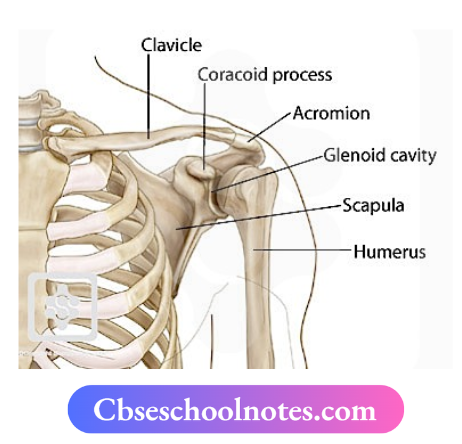
It performs the following functions
- Collar bones on the two sides of the neck keep our shoulders apart.
- Shoulder blades connect the arms to the body
Pelvic Bones
The pelvic bone forms a large, basin-shaped framework at the lower end ofthe backbone, to which the legs are attached.
The pelvic bone is also known as the hip bone. This bone encloses the portion of the body below the stomach. It is also the part ofour skeleton, we sit on.
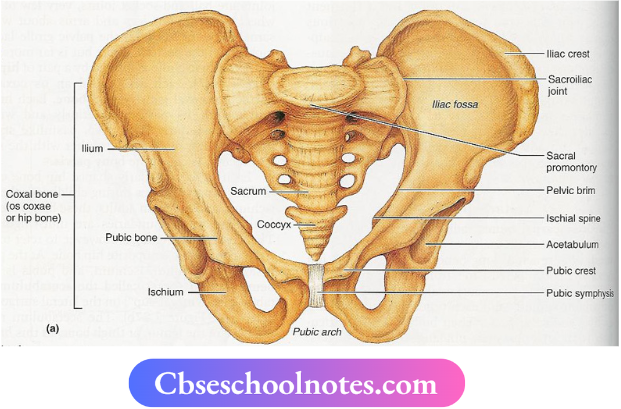
It performs the following functions
- Pelvic bones protect and support the lower organs of the body.
- It attaches the legs to our body.
6. Bones of the Hand
Our hand is made up of three parts, i.e. wrist, palm, and fingers. The wrist is made up of several small bones called carpals that make the wrist flexible. Each finger is made up of three bones.
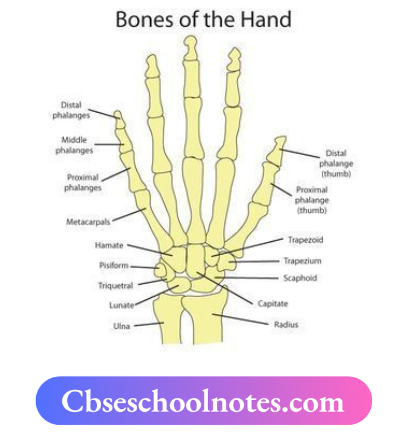
X-Ray Images of Our Bones
We can have some idea about the shape and number of bones in some parts ofour body by feeling them. The other way of knowing about bones is to look at X-ray images.
Sometimes when we are hurt or have an accident, doctors use these X-ray images to find out about any possible injuries that might have happened to the bones. The X-ray shows the shapes of the bones in our bodies.

Cartilage
These are the additional parts of the skeleton that are not as hard as the bones and can be bent easily. Most ofthe skeleton is made up of bones, but it has some cartilage too. Cartilage is a kind of soft and elastic tissue present in the following parts ofour body.
- It is present in the pinna of the ears (upper part).
- It is present at the tip of the nose.
- It is present (as cartilage discs) between the vertebrae of the backbone.
- It is present at the end of bones, i.e. the point where one bone joins the other at a joint.
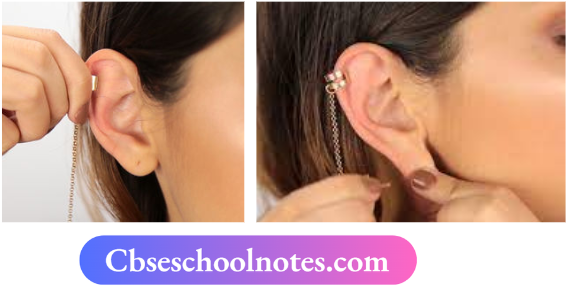
Muscles
Bones cannot move by themselves. The muscles attached to the bones make them move at joints.
Contraction and relaxation of muscles make the bone move up and down. You can observe the contraction of muscles in your leg when you walk or run. When contracted, the muscle becomes shorter, stiffer, and thicker.
It thus, pulls the bone. Muscles work in pairs. When one of them contracts, the bone is pulled in that direction.
At the same time, the other member of the pair relaxes. To move the bone in the opposite direction, the relaxed muscle contracts to pull the bone towards its original position, while the first axes.
A muscle can only pull. It cannot be posh. Thus, two muscles have to work together to move a bone. For example, the up and down movements ofour arms are controlled by two muscles namely, the biceps and triceps.
When we want to raise our arm, the biceps in front contract, Le. become shorter to pull up the arm. To lower the arm, the triceps at the back contract and pull it down.
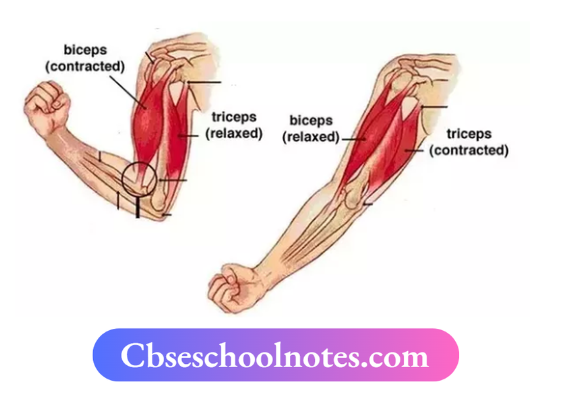
Gait Of Animals
Different animals use different organs to move from one place to another. So, the manner of movement, i.e. the gait also differs in different animals, for example, birds-fly, fish-swim, and snakes-crawl. We will discuss some ofthese movements in detail.
1. Earthworm
An earthworm does not have legs and bones. The body of an earthworm is made up of many rings that are joined end to end. It moves by alternate expansion and contraction of the body, that is by the muscles.
Movement in Earthworm
- An earthworm first extends the front part of the body, keeping the rear portion fixed to the ground.
- Then it fixes the front end and releases the rear end. After releasing the rear end, it then shortens the body and pulls the rear end forward. This makes it move forward by a small distance.
- In this process, the large number of minute movable bristles connected to the muses help in gripping the ground. These bristles are hair-like structures projecting out of the body of the earthworm.
- Earthworm’s body also secretes a slimy substance that helps in its movement by reducing friction Thus, by the repeated expansion and contraction of muses, earthworm moves through the soil.
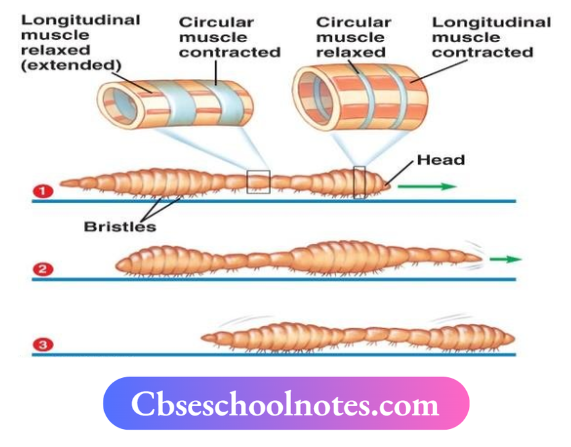
Science Insight The earthworm eats its way through the soil. Its body then throws away the undigested part of the material that it eats. This activity of an earthworm makes the soil fertile and more useful for plants.
Snail
The body of a snail is soft and consists of a head, foot, and shell. The shell is the outer skeleton of a snail which is not made up of bones. It is a single unit and does not help in its movement. The foot of a snail is a large, thick structure made up of strong muscles.
Movement in Snail
- Movement in snails occurs with the help of a muscular Shell Hegd wide foot. The contraction and relaxation of muscles push the body of the snail forward. However, the Slimy surface movement of the foot is slow A snal1 and is controlled by the muscles attached to it.
- The foot secretes a slimy substance which helps the snail to slide over the ground and drag its heavy shell with it.
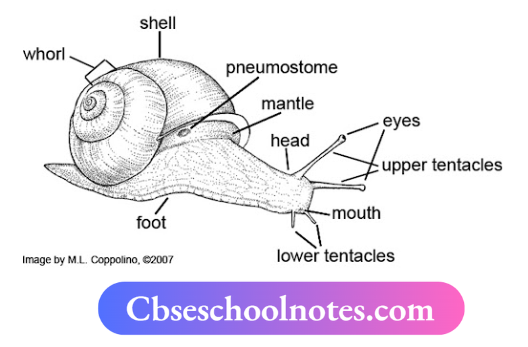
Science Insight Snails are commonly known as belly-footed animals. The broad flat muscular foot runs along its belly and is used for support and to carry out movement.’
Cockroach
A cockroach can walk, climb, and fly upto a short distance. It has an exoskeleton that covers the outer body. This outer (or exo) skeleton is made up of some plates joined together. These plates permit the movement of the cockroach body.
Movement in Cockroach
- It has three pairs of jointed legs attached to the breast region which help them to walk.
- Its legs have distinct muscles that move the legs for walking and climbing.
- Its wings are attached to the body muscles that help in the movement of wings as it flies.
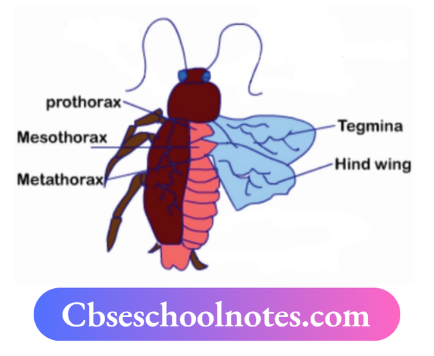
Birds
The birds fly in the air and walk on the ground. The birds can fly as their bodies are well suited for flying. Some birds like ducks and swans can also swim in water.
Movement in Birds.
- It has hind limbs (legs) for walking on the ground and wings for flying.
- The birds fly in the air by moving their wings up and down continuously.
- The main adaptations in the bodies of birds that enable them to fly are as follows
- They have hollow and light bones which makes their bodies light
- The bony parts of the forelimbs are modified to form wings for flying.
- The breast bone is modified to hold the muscles of flight. These muscles are used to move the wings up and down during flight.
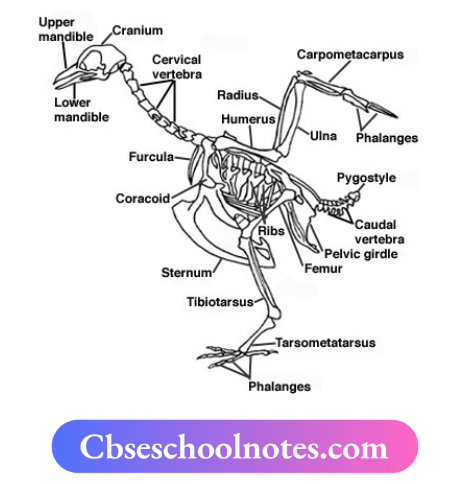
Fish
Their body is like a boat, i.e. the head and tail are smaller than the middle portion. It is known as a streamlined body, i.e. body that tapers at both ends. This shape reduces friction in water and allows them to swim easily.
Movement in Fish
The skeleton of a fish is covered with strong muscles. Movement in fishes occurs due to the action of their muscles and fins.
- During swimming, the muscles make the front part of the body curve to one side, while the tail part swings towards the opposite side.
- The fish thus, forms a curve. Then quickly, the body and tail curve to the other side. This makes a jerk and pushes the body forward and helps in their movement. A series of such jerks make the fish swim ahead.
- Fish have several fins which helps them to keep the balance of the body. The fins also help to determine the direction, while swimming.

Snake
It has a long backbone which is very flexible. The body of a snake contains many thin muscles that are connected. These muscles also interconnect the backbone, ribs, and skin.
Movement in Snake
- The snake can curve its body into many loops. Each loop pushes the ground to give a forward push to the body against the ground.
- Since its long body makes many loops and each loop gives it a push, the snake moves very fast and not in a straight line. This kind of movement in a snake is called slithering.
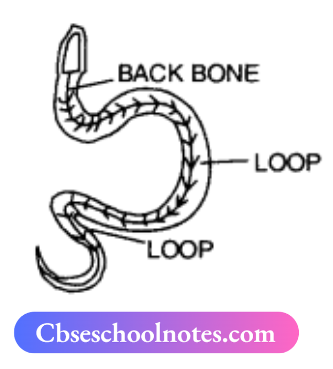
Yoga-For Better Health
Yoga is an invaluable gift of the ancient Indian tradition. The United Nations declared June 21 as the International Day of Yoga. Yoga helps in keeping the backbone erect and in relieving joint pain. Many postures in yoga require lifting of our body weight.
This helps in making the bones strong and preventing osteoporosis. Yoga keeps the heart healthy and helps it to work more efficiently. Thus, yoga keeps a person healthy. However, certain yoga postures should be performed under the supervision of a trained person.
Activity 1
Aim: To show that we can bend or rotate our body only at joints.
Materials Required: Scale or wooden stick and string.
Procedure:
- Straighten your right arm. Place a light wooden stick lengthwise on your arm so that your elbow is in the center.
- Ask your friend to tie the wooden stick with the arm at both ends by using a string.
- Now try to bend your arm at the elbow.
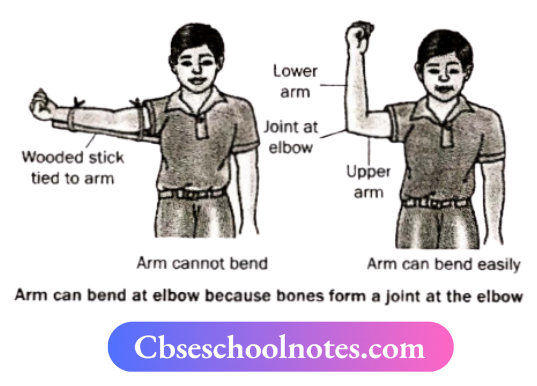
Observation: Since a wooden stick is tied at the joint of the elbow you will not be able to bend your arm.
Conclusion: This activity shows that we can bend or move our body parts only at those places where two or more bones are joined together. These places are called joints.
Activity 2
Aim: To make a ball and socket joint.
Materials Required: Old rubber or plastic ball paper, bowl, Knife/scissors.
Procedure:
- Roll a strip of paper into a cylinder.
- Make a small hole in an old rubber or plastic ball.
- Push the paper cylinder into it.
- Put the ball in a small bowl.
- The ball and socket joint is ready.
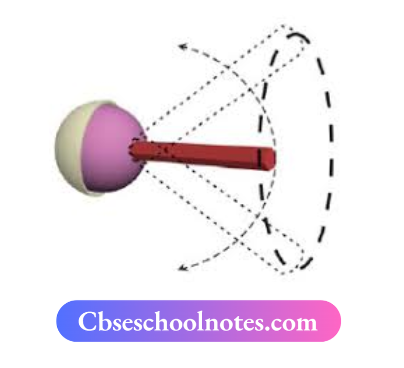
Observation: In this type of joint, the rounded end of one bone fits into the cavity of the other bone. It allows movement in all directions.
Conclusion: From this activity, it can be concluded that this joint is a ball and socket joint.
Activity 3
Aim: To show that hinge joints allow movement only in one plane and only upto 180°.
Materials Required: Cardboard or thickchart paper and pencil.
Procedure:
- Make a cylinder with cardboard or thick chart paper.
- Attach a small pencil to the cylinder by piercing the cylinder at the center.
- Now make a hollow half-cylinder in such a way that the rolled-up cylinder fits inside the half-cylinder easily.

Observation: The hollow half cylinder with the rolled-up cylinder sitting inside it allows movement like a hinge.
Conclusion: From this activity, it can be concluded that hinge joints allow movement only in one plane and upto 180°.
Activity 4
Aim: To observe how an earthworm moves.
Materials Required: An earthworm, a piece of blotting or filter paper, smooth glass plate.
Procedure:
- Observe an earthworm moving on the soil in a garden.
- Gendy lifts it and places it on a piece of blotting or filter paper.
- Observe its movement.
- Then place it on a smooth glass plate or any slippery surface.
- Observe its movement again.
Observations: We will observe that earthworms can move easily on the soil, but find it difficult to move on filter paper and glass plate.
Conclusion: This activity shows that an earthworm can move easily on the soil. It has a large number of tiny bristles (hair-like structures) under its body. These bristles help to get a good grip on the ground. It is difficult for it to move on paper and glass because it cannot get a grip on both of them.
Activity 5
Aim: To observe the movement of a snail.
Materials Required: Snail and a glass plate.
Procedure:
- Place a snail on a glass plate and observe it.
- When it starts moving, carefully lift the glass plate along with the snail above the level of your head.
- Observe the movement of the snail from beneath the glass plate.
- Now tilt the glass plate.
Observation: A thick structure and head may come out of an opening in the shell. The thick structure is its foot, which is made up of strong muscles. Conclusion This activity shows the wavy motion ofthe snail’s foot.
